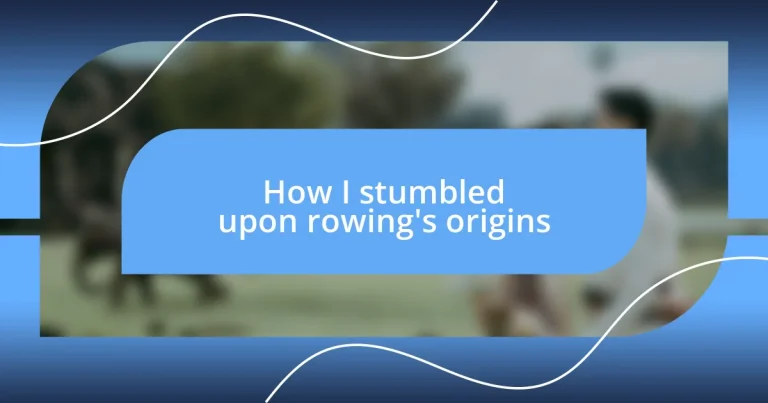Key takeaways:
- Rowing’s history reflects societal changes, transitioning from a symbol of status in ancient Egypt to a competitive sport uniting communities in ancient Greece and 18th-century England.
- Key figures like Thomas Doggett and Sir Steve Redgrave significantly influenced the sport, with innovations in racing events and boat design that propelled rowing forward.
- Modern advancements focus on biomechanics and teamwork, blending traditional techniques with scientific insights to enhance performance and deepen connections among rowers.

Understanding the history of rowing
Rowing has roots that trace back to ancient civilizations, showcasing humanity’s early connection with water. Imagine the power of those first oarsmen, gliding along rivers as they navigated trade routes or engaged in competition. Doesn’t it make you wonder how the simplicity of a boat and oars evolved into the sophisticated sport we now embrace?
In my experience, the history of rowing reflects not just a progression of techniques but also a change in societal values. For example, in ancient Egypt, rowing was a symbol of status, while in Greece, it became a competitive sport that brought communities together. Can you picture the excitement of those competitions, where athletes rowed not just for victory but for glory?
Moreover, as rowing transitioned through the ages, it became a means of forging camaraderie and connection. In the 18th century, the establishment of organized competitions in England heralded a new era for the sport. There’s something stirring about understanding this lineage; every stroke taken today echoes the efforts of countless rowers before us. Have you ever felt that exhilarating connection to history while in a boat? It’s a feeling that truly enriches the experience.

Discovering ancient rowing practices
As I delved into the world of ancient rowing practices, I discovered a fascinating tapestry woven from cultures around the globe. The techniques of these early rowers varied, but the purpose was often the same: survival, trade, and the thrill of competition. I vividly recall the moment I first learned about the longboats of the Vikings, which were crafted not just for exploration but for their swift raids along coastal settlements. It made me contemplate how those same waters have transformed from battlegrounds into serene landscapes for today’s recreational rowers.
- Ancient Egyptians employed rowing for transport and ceremonial purposes, often depicted in tomb paintings.
- The Greeks introduced competitive rowing during the ancient Olympic Games, symbolizing both strength and communal spirit.
- The Inuit used a unique style of kayak rowing, showcasing their deep understanding of the Arctic waters.
- The Chinese developed the dragon boat, which remains a vibrant cultural and competitive sport today.
Each of these practices tells its own story, reminding us that rowing has always been more than just a sport—it’s an expression of culture and humanity’s enduring relationship with water.

Exploring early competitive rowing
Examining early competitive rowing reveals an intriguing blend of community spirit and individual prowess. In ancient Greece, rowing competitions were not merely contests; they were events that brought citizens together, fostering a sense of unity and excitement. I can almost hear the cheers echoing through the stands as rowers strained against the water, driven by both personal ambition and the pride of their city-states. How exhilarating it must have been to compete not only for oneself but for the honor of one’s community!
Fast forward a few centuries, and we see rowing clubs emerging in England during the 18th century. They became social hubs where people gathered to share their passion for the sport while competing against one another. I recall learning about the Cambridge vs. Oxford Boat Race, a tradition that underscores the rivalry and camaraderie that competitive rowing incites. This annual event sparked my curiosity about how such competitions shape not just athletes but communities as well. Have you ever participated in something that brought people together in a powerful way?
Today, as I watch modern rowing competitions, I can’t help but feel a sense of connection to those early rowers. The heartbeat of competitive rowing has remained the same, regardless of the era: it’s about the relentless pursuit of excellence, a celebration of skill, and the joy of racing against others. Each stroke in today’s races resonates with the strength and spirit of history, reminding me of the profound legacy of this remarkable sport.
| Historical Context | Key Features |
|---|---|
| Ancient Greece | First competitive rowing events, fostering community unity. |
| 18th Century England | Emergence of rowing clubs and traditions like the Oxford-Cambridge Boat Race. |

The influence of rowing cultures
The influence of rowing cultures is remarkably diverse, reflecting the distinct values and environments of various societies. I remember thumbing through a beautiful book filled with illustrations of dragon boat races. The colors and energy portrayed made me appreciate how this Chinese tradition fosters strong community ties and cultural pride. Can you imagine the thrill of not just racing but performing as a cohesive unit, each stroke echoing the rhythm of historic festivals?
In contrast, the Inuit’s kayak techniques highlight a deep connection with their surroundings, reflecting adaptation and respect for an unforgiving landscape. I often think about how their skills weren’t just about sport; they were about survival. Engaging with such rich traditions prompts me to reflect on my own experiences with water-based activities. Have you ever felt a similar bond with nature while participating in a sport?
Looking back, I find it fascinating how each rowing culture, from ancient Egyptian transports to competitive Greek galleys, has shaped my understanding of rowing as a multifaceted art. It’s not just a physical activity; it’s a vibrant expression of identity and community. The thought that every stroke taken today carries whispers of these rich histories fills me with excitement—what stories are waiting to be discovered behind each oar?

Key figures in rowing history
Understanding the key figures in rowing history adds a richer texture to the sport I admire so much. Take Thomas Doggett, for example. His establishment of the Doggett’s Coat and Badge in 1715 not only created one of the oldest rowing races in the world but also sparked a competitive spirit among rowers in England. I often think about how that event, born from a playful bet, transformed into a cherished tradition that continues to inspire rowers today. Isn’t it amazing how one individual can impact a sport for centuries?
Then there’s John Charles Kerwin, a name that resonates especially with me. His agility in innovating boat designs in the late 1800s pushed the limits of what was possible on the water. I remember listening to a podcast where a historian discussed how his lightweight designs revolutionized competitive rowing. It made me realize how these technological advancements are often driven by passionate individuals who see a possibility where others don’t. Have you ever felt compelled to chase a vision that might change how things are done?
Let’s not forget about Sir Steve Redgrave, whose unparalleled success in championship rowing, including five Olympic gold medals, truly highlights what it means to commit to excellence. I recall being caught up in the excitement during the 1996 Olympics when he soared to yet another victory. Watching him paddle with unwavering determination and grit ignited a sense of admiration in me. How can one not be inspired by someone who dedicates their life to a craft, continually raising the bar for future generations? Each of these figures hasn’t just shaped rowing; they’ve woven threads of inspiration into the fabric of its history.

Modern evolution of rowing techniques
The evolution of rowing techniques in modern times has been nothing short of remarkable. I recall a time when I first saw a sculling boat glide past me in a local race; the seamless strokes of the oars seemed almost choreographed. It made me ponder how innovations like carbon fiber and improved hull designs have reshaped not just the boats, but also the very technique athletes use. How much more efficient do you think rowing has become with these advancements?
One major shift I’ve noticed is the emphasis on biomechanics and strength conditioning. During a training session, a coach explained how understanding body mechanics could enhance stroke efficiency. I remember the lightbulb moment when I realized my own technique could improve significantly through simple adjustments. It’s fascinating how science and technology now play such pivotal roles in coaching, allowing rowers to fine-tune their performance with precision. Have you ever tried a new technique that changed the way you approached a sport?
As I’ve watched various races over the years, it’s clear that modern rowing techniques embrace a blend of tradition and innovation. The rowers’ unified movements showcase the evolution of teamwork, fueled by insights from psychology and group dynamics. I can almost feel the camaraderie in those boats as they sync their strokes, making me think about the deep sense of connection forged among teammates. Isn’t it inspiring to witness how far rowing has come, melding age-old practices with contemporary knowledge?

Personal reflections on rowing’s journey
Reflecting on rowing’s journey, I find myself captivated by how this sport has evolved alongside its athletes. My first experience rowing on a calm lake introduced me to a blend of tranquility and exertion that I never expected. Each stroke felt like a dialogue with the water, and it struck me just how deeply interconnected we are with the forces of nature. Have you ever felt such a profound connection to an activity that it molded your understanding of movement?
There’s a tapestry of unity woven throughout rowing’s history that resonates with me. I remember participating in my first team rowing practice, the thrill of the boat slicing through the water as my teammates and I synchronized our strokes. There was something almost spiritual about it. The laughter and encouragement among us reminded me of the camaraderie that has spanned centuries in this sport. Isn’t it remarkable how rowing cultivates not just individual strength but a deep sense of belonging?
I often think back to the impact of rowing’s origins on today’s competitive spirit. While watching a friend compete last summer, I felt a rush of nostalgia as he navigated the course. Each push against the oars felt reminiscent of the determination shown by those early rowers. It made me ponder how our modern challenges echo across generations. How does our journey in this sport connect us to the past and inspire us to forge our own paths today?














